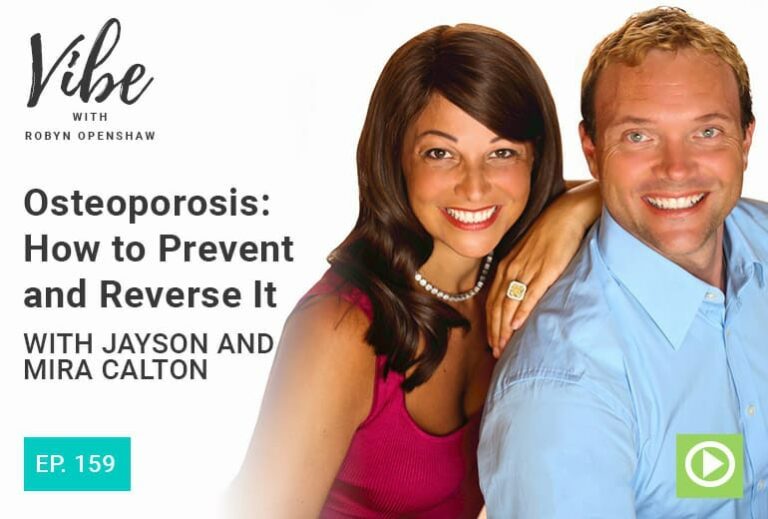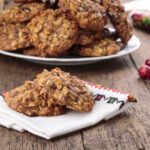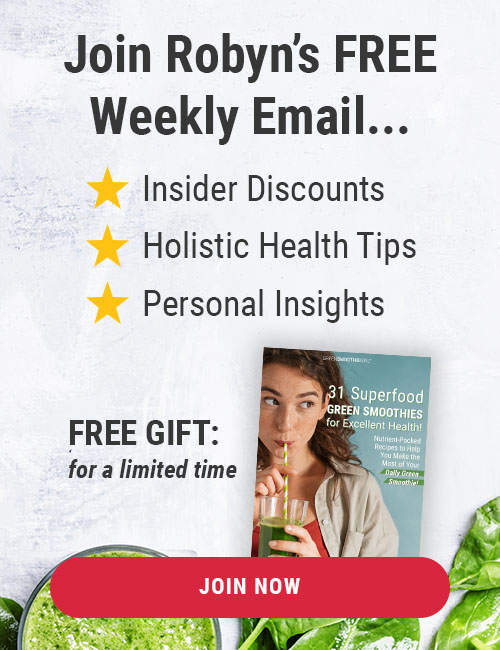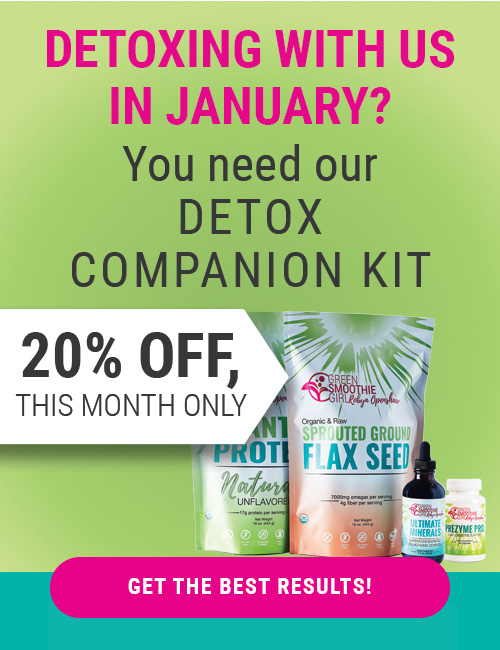Ep.159: Osteoporosis: How to Prevent and Reverse It with Jayson and Mira Calton

Podcast: Play in new window
How do you eat, to prevent (or reverse) osteoporosis, and osteopenia? What are the issues with supplements in treating bone loss? Dr. Jayson and Mira Calton are the authors of a new book all about this.
LINKS AND RESOURCES:
Get the book: “Rebuild Your Bones”
Check out the website for info and bonuses
EPISODE HIGHLIGHTS WITH DR. JAYSON AND MIRA CALTON:
- [03:53] Am I losing my bone mass? We hit our peak bone mass around 20 years old. But that doesn’t mean you have to lose 1% of your bone per year – Dr. Calton has something to say about that.
- [06:32] Weight-bearing exercise is a needle mover. What else can you do to help your bone mass? The Caltons have “40 Healing Habits” for you to learn about.
- [10:05] What causes osteoporosis? Mira Calton had the bones of an 80-year-old at the age of 30. What lifestyle choices make you more susceptible to this disease, and why are kids getting this diagnosis?
- [15:16] Our dietary approach to curing osteoporosis. The Caltons have developed a balance of micronutrients for the optimal diet to help osteoporosis (and elimination is not the name of the game). Everyone is deficient in something.
TRANSCRIPT:
This transcript has been edited for clarity. Robyn: Hey everyone. Welcome back to the Vibe show. Today I’m introducing you to my friends Jayson and Mira Calton. Jayson’s a PhD and both of them are nutritionists and they’re really out there talking about the importance of micronutrients. Their latest book is about osteoporosis. And I’m really glad because there’s very little written out there about osteoporosis. It’s like cancer and heart disease and autoimmune disease have just eclipsed this other issue we have, which is the fact that the vast majority of us have very thin bones. And this isn’t going to take us into old age very well. Their brand-new book coming out is called Rebuild Your Bones: The 12-Week Osteoporosis Protocol. They have the Calton nutrition and Calton Institute of Lifestyle Medicine in Florida, and they’re also authors of some other books called The Micronutrient Miracle, Naked Calories, and Rich Food, Poor Food. And they’ve been featured in the Wall Street Journal, First For Women, Fox, CNN, PBS. I’d love to introduce you to Jayson and Mira Calton. Welcome to the Vibe show, Jayson and Mira Calton. Caltons: Hello. Thanks for having us. Robyn: You guys have done so many interviews together. You talk at the same time. One of you is a doctor, you’re both nutritionists; you have a brand new book out and you’re old hat authors. You’ve written on other topics. But now you’re taking on osteoporosis. I’m super excited about that because, funny thing is, I had been talking to you about your book, and checking out your book, and I knew that you were launching it soon. And right before that I had this health coach who follows me on Facebook and she private messaged me and she’s like, “I can’t find what I should tell clients I’m working with who have osteoporosis. What should I tell them about how to eat? Where’s the source?” And I’m like, “Well, give me a minute because I am about to interview the Caltons.” Tell us about the name of the book, and just tell us why — this subject of osteoporosis — why is it captured you in your research, and why is it personal for you? Mira Calton: The book is called Rebuild Your Bones: The 12-Week Osteoporosis Protocol. We’re really passionate about it because this is the book that I wish somebody had written when I was first diagnosed with advanced osteoporosis when I was 30. The doctor told me that I had the bone density of an eight year old. So, not only was that shocking, but, like everyone else out there, I started to try to figure out what to do, like the woman who came to you asking you as well. And I could not find any good information. I was one of the lucky ones. Luckily I found Dr. Calton, and we started working together on a protocol and we were able to reverse my osteoporosis. I’ve been 15 years osteoporosis-free, and now we put all of the information in the book. We put in the actual protocol that we used on me, the protocol that we use on hundreds of people around the world. It’s worked for me, and we’re really excited to get the information out. We are on a mission to stop, prevent, and reverse osteoporosis for a million people out there. Robyn: It’s really inspiring that, if you were diagnosed with severe osteoporosis at the age of 30, and now you’re, I think — I’m going to guess at your age, you’re 15 years past that, ish — Mira Calton: Plus. Robyn: — yes, we don’t ask a lady her age — I think that this is going to shock some people that you can actually reverse osteoporosis. Because we were always told that we build bone until we’re, I want to say 20 or so, and then after 30 you can only go downhill from there. All you can do is slow the loss of bone. Is that wrong? Dr. Calton: Well, in a way it’s right and in a way it’s wrong. You’re right. We hit our peak bone mass around 20 years old, and then what they tell you is on average you lose about 1% of bone per year. But that’s like kind of saying on average, you age the equivalent of what one year is, every year of your life, no matter what you do. But we know that that’s not true. We know that if we take care of ourselves, if we exercise, if we eat right, if we take the right supplements, if we eat the right foods, we don’t age the same way as somebody who just doesn’t take care of themselves. Someone who smokes and drinks and doesn’t even follow a diet at all, and does bad things for themselves. That’s going to cause aging much faster. While we do lose bone as we age to a certain extent over time — that’s going to be inevitable — the rate that we do it is in your control. I think osteoporosis is looked at very much like a disease that old people get. But it’s not anymore. I like to compare it to type two diabetes. 20 years ago we used to call type two diabetes, “adult onset diabetes.” If you got that, your doctor would say, “Hey, you need insulin. That’s the rest of your life. This is going to be a life sentence. You’ve got type two diabetes.” Well, now we don’t call it adult onset diabetes anymore, because everybody gets it. Younger people, even children; there’s over 135,000 kids in America who have it. Osteoporosis is the same thing. We know it’s not a life sentence anymore. It’s a lifestyle disease that we can control through diet, lifestyle and proper supplementation. And that’s what we’re here to try to teach in the book. We give you what we call, “40 Healing Habits” that, individually, have all been clinically proven in some way, shape or form to increase your bone density. But when you link them all together and use them in the way that we’ve given them to you here, they work like chain mail armor, kind of protecting you from osteoporosis. Robyn: I got a bone density test when I was probably 43. I’m 52 now. And they told me I had the bones of a 20 year old. And so I was just like, “Cool, awesome.” And I haven’t really haven’t thought about bone density since. But back when I was studying it a little bit it seemed like weight-bearing exercise was the number one needle mover, like way bigger even than (of course we’re going to talk in depth about what nutrition has to do with it, which is like everything), the number one thing was weight bearing exercise. Do you think that the research supports that, or is that wrong? Mira Calton: That’s absolutely one of the 40 Healing Habits, is doing the right kind of exercise. This is the way we look at it: your bones need to be fed, and the food that goes into your bones is micronutrients. Your vitamins and your minerals, the protein; that’s what feeds the bone in order to grow. But the bone needs something else, and that’s stimulus. And that’s where the weight-bearing comes into it. There’s actually something called osteogenic loading, which is a step further than weight-bearing exercise and that’s what the newest science is. A very specific type of a load, that when you put it on bone, it stimulates it to eat the food, or take in the nutrients and to grow. Robyn: I actually really dislike lifting weights, and I just feel lots of guilt because I haven’t done it. When I started playing tennis competitively, I just pretty much never lifted weights again. Or I’m very sporadic about it. Is yoga good for preventing osteoporosis? Because that I’m good at Mira Calton: Your tennis is kicking butt! Because you’re running around. You can get osteogenic loading from running every time you do a hop, or you land (it’s that land which you get a lot in tennis, that hard land where you stop real fast, every time you do that) that’s asked eugenic loading. So that’s great what you’re doing. Robyn: Okay; I do the cardio and I do lots of yoga. I just don’t like lifting weights Dr. Calton: Lifting weights, like Mira said, is one of the 40 Healing Habits. If you came to us and said, Hey I don’t have the bone density of a 20 year old, I’ve got bone density of an 80-year-old,” like Mira had, and you’re asking us, “What can I do?” One of those things would be to stimulate the bone. It doesn’t mean lifting weights. Let’s talk a little bit about more about that. That osteogenic load that Mira mentioned is actually 4.2 times your body weight. That’s the amount load that science has shown will actually stimulate bone growth. Now for a 120 pound woman, that’s 500 pounds; so you’re not going to get that osteogenic load by doing arm curls or squats in the gym. That kind of weight-bearing exercise — that’s such a vague term — does not do it. Yes. That helps you build muscle. Yes. It helps you improve your metabolism. Yes. It’s good for you overall. But it’s not the kind of load that’s going to increase your bone density. The people with the highest bone density are actually gymnasts. It’s when they come off the bar and they land on the pad — that impact load — that’s that kind of load that’s going to do it. So things like Mira was saying — that tennis, running, hopping, jumping — that kind of thing is really good for you. Some of those things you are probably doing in some of your cardio classes. But as far as yoga is concerned — yoga is great, yoga has a lot of benefits to it, but as far as bone building is concerned, it’s not going to provide that 4.2 osteogenic load. It’s going to provide other benefits like muscle support and balance so that you don’t fall and fracture a bone if you have osteoporosis. Robyn: A different answer than I was expecting, because my question was wrong really. I’m super curious about why, Mira, do you think you had the bones of an 80-year-old at the age of 30? What was your lifestyle up until that point? Knowing what you know now, looking back, why did you have such thin bones? Mira Calton: I say that I had the perfect osteoporosis diet and lifestyle. And by that, I don’t mean to fight it, I mean to give it to myself. So. I was into fat-free foods. You need fat to absorb certain micronutrients — A,E, D, K, some of those are either the fat soluble micronutrients — I was in a fat free lifestyle so that wasn’t helping. I was eating sugar. Sugar blocks very specific micronutrients including calcium and magnesium from getting into your body. I was eating fat-free muffins loaded with sugar from Starbucks every morning. Every single day I was doing the same exact things. I was really into cardio. Again, cardio utilizes your micronutrients even faster. You don’t want to be doing that if you have osteoporosis. I was high, high stress. I lived in Manhattan, I always had a high, high stress job. Stress is problematic for osteoporosis because again, it messes with your hormones. And when cortisol rises during periods of stress, you don’t allow the body to absorb calcium. Additionally, you utilize a lot of your B vitamins faster, as well as your calcium and your magnesium. For me it was a layering effect. One thing on another, on another. I didn’t sleep hardly at all. I worked as a publicist; I had to stay out to be the last person at the party to make sure I could call the magazines in the morning and tell them who was there, doing what with whom. Again, sleep. You need to get sleep. Basically, out of the 40 healing habits, I think maybe I did one right. I was the perfect example of why someone gets osteoporosis. Robyn: Perfect storm, you didn’t know any better. Let’s go to the kids; I have definitely read that they’re big soda drinkers and that that’s linked to osteoporosis. But what else? Why do we have younger and younger people getting osteoporosis? Talk a little about what it is. We all know thinning bones; but go into a little more scientific detail, and why are the young people getting it now? Dr. Calton: Osteoporosis literally means porous bone. It’s a disease where the quality and the density of the bone are reduced, and the risk of fracture is increased. The World Health Organization has defined osteoporosis as being what’s called a negative 2.5 for the testing. So when you go get a DEXA scan done, there’s an actual amount of bone density loss that you will have achieved to achieve osteoporosis. And if you lose a little bit less than that, you have osteopenia, which is just low bone density. Why are kids getting it and why are adults getting it? It really comes down to osteoporosis is a micronutrient deficiency disease. Clear and simple. When we lose bone, we are losing calcium from the bone. We’re also breaking down that bone matrix, which is mostly a protein matrix, but it’s because our bodies don’t have enough of the essential micronutrients that they need, that they need to go scavenge it where we store it. So, becoming deficient in those essential micronutrients is a causative effect. And because more and more of us are doing that these days because our food is processed — we’re shipping it in from sometimes other continents, so they’re picking the food prematurely before it has time to absorb the nutrients from the soil and shipping it thousands of miles to us. We are buying foods that we’re not buying local anymore and then eating them that night. We’re buying foods that might have been picked weeks before and every minute of every mile that the food travels or spends time in the grocery store. It loses its micronutrients. We know that our poor children are being fed these processed foods, oftentimes very restrictive diets. They’re not getting the vitamins and minerals they need. They’re under high stress. There’s all kinds of different things. It’s almost that perfect storm happening for micronutrient deficiency and as that occurs more and more, we’re seeing more and more people with osteoporosis. We’re even seeing men, a lot of military men in their thirties are coming back from Iraq and Afghanistan with osteoporosis. Robyn: Wow. I think we have an epidemic coming there. I’ve been watching you guys for years, and you’ve been beating the drum about micronutrients. Which I really appreciate, because this is not the only disease that you’ve linked to micronutrient deficiency. Everybody’s obsessed with the macro nutrients, and they’re counting their grams of proteins, fats and carbs. And over here on the green smoothie girl side I’ve been saying this for years. That’s not where the story is told. People are just so worried about their proteins, fats and carbs. Which decade are we in? Which one of the macronutrients are we obsessed with this decade? Hey people, they’re all good. We need them all. We have to have all three proteins, fats and carbs. Talk a little bit about your dietary approach to dealing with osteoporosis. Mira Calton: We love that you said that because that’s where things going wrong with our community — it’s all this infighting you’re mentioning. Are you right because you’re low carb? Are you right because you’re Keto? No one can get along in the room. The real truth is that everyone’s right and everyone’s wrong. Everyone is correct that there are benefits to their program and everyone needs to look at where their programs have pitfalls because all dietary programs are one thing. Elimination. If you’re a vegan, you’re eliminating animal products. If you’re paleo, you’re eliminating lagoons and dairy. If you’re low carb, you’re eliminating carbs. It’s understanding what you’re eliminating and making sure that you’re paying attention to it so you don’t get a lifestyle disease or nutritional deficiency disease. That’s why we decided that we have, as our word called a nutrivore, and you can follow our program, rebuild your bones regardless of dietary perimeters because you could be a nutrivore. A nutrivore is just someone who says, you know what? I’m going to look at my micronutrients, my vitamins, minerals, essential fatty acids and amino acids rather than my macronutrients. I’m putting this first. This is what’s important regardless of what you believe in or anything else. And if we can all get under that umbrella; we can all find out that we have a lot more in common and stop this fighting and get somewhere in nutrition. Dr. Calton: You know Robyn, I’m so glad you brought this point up because there really is only one truth in nutrition, and that is you must be sufficient in your essential micronutrients if you are going to achieve optimal health. There is no doctor or nutritionist or anyone anywhere who will say, “You can be deficient in these essential nutrients and still have optimal health.” [Having balanced micronutritional health] is the only universal truth of anything. If we can put that, like Mira said, at the forefront and say, “Be a vegan, be a vegetarian, be a paleo, have a Mediterranean diet.” That is your nutritional philosophy for right now and maybe your whole life. And that’s absolutely fine that you’ve chosen that as your doctrine, but you cannot be healthy choosing whatever nutritional profile you’ve felt you’ve chosen if that nutritional philosophy is deficient in your essential micronutrients. That’s kind of empowering because it can bring the communities together. We can come under one umbrella. “I may choose not to eat any animal products, but I know for sure that I’m going to look at my vegan or vegetarian diet and I’m going to say this is what research actually shows I’m deficient in based on the foods that I’ve eliminated,” like Mira said. “I’m going to recognize that I’m going to take responsibility for that. I’m going to fill my gaps in the way I can.” Same thing’s true on Keto or paleo, and like she said, there is not been one study ever published by anyone — and this is an important point — that is ever been able to show that you are able to get the minimal levels of your essential micronutrients from food alone. Every diet fall short in some way. That’s another reason to bring us together. We all have pitfalls, but we know we can fill those pitfall gaps through a micronutrient sufficiency. And then we can move forward from there. Robyn: Yeah. I don’t know if I’ve told you guys that I take my followers to Switzerland every summer, but I’ve been doing this for I think eight years, maybe nine. I have about 60 or 80 people that I get to spend a lot of time with, so I really get to know them. [There are] no HIPAA laws — it’s a very informal environment — so, they’ll show me their oligoscan results — the ones who stay two weeks, which is most of them — will show me their mineral deficiencies from this noninvasive test that mostly isn’t here in the US yet. It’s a Swiss test called the oligoscan. I talk about this a lot because it was such a shock to me to get the results myself that our Ultimate Minerals is our number one bestselling product. It’s just fulvic and humic acid. I’m sure you’ll tell us about your supplements because you feel that supplementation is necessary. I want to get into why is it we can’t get, get it from foods? I mean, I know what I think the answer is, but I’m interested in yours. I see everyone has deficiencies and some of them are critical deficiencies. Like probably the number one deficiency I see as I look at everybody’s oligoscan. Like I said, if I were in a medical office, I wouldn’t [say], “Give me those charts. I want to check everybody’s charts.” But in Switzerland, everybody just shows me their tests. We eat three meals a day together, so we’re talking about our tests and we’re talking about our heavy metals levels. We don’t want to have any of those. We just talk about our minerals levels. We do all want to have optimal levels of those, and everybody’s low in something. Most people are low in three, four, five, six of these micronutrients. My guess is and the reason people aren’t clued in, and you guys are having to beat this drum for years and years and years now is that we can remember proteins, fats and carbs, but there’s a lot of micronutrients to remember. Talk about why are we deficient. I’m always talking about how most mineral supplements are from ground up rocks or chalk, which I don’t think is very well absorbed by the body. Take on some of these subjects that I’m laying out here. Mira Calton: I first wanted to get to what you were saying about how everyone has deficiencies. This is one of those things that we really talk about how to rebuild your bones. Everyone looks at it says, “I have osteoporosis because I have a calcium deficiency. I’ve been told that it’s calcium and vitamin D [problem]. That’s my doctor told me.” And we blow that out of the water because your micronutrients are an orchestra. A to Z, the amino acids, there’s four different parts of a regular orchestra and there are four different families of micronutrients. If you imagine that every single instrument has to be in the pit for the orchestra to actually perform a piece of music, every single nutrient must be there at the time that your body has to do a function. If the function is performed properly, no nutrient can take another nutrients place. They don’t do each other’s jobs, and some have to be there to support. Even if you don’t hear that instrument in the orchestra, you know there might just be one point where he makes somebody else sound so much sweeter because of the note that he plays. We don’t know. The same thing is true of micronutrients. They all help support each other one after another. And we want to make that point clear because when people are thinking about their supplementation, it really is that A to Z. Don’t pick and choose because that can cause further problems. I just want to make sure that everyone understood that first. The problem is everyone sort of leaves out all the other ones that we actually have an entire chapter in the book where we go through every single micronutrient and what it does for bone. And they are all 100% necessary. Robyn: There’s so many standard-of-care doctors that are just like, just take calcium and that’s pretty useless, right? Mira Calton: Yeah. Calcium can be dangerous if you’re not taking vitamin K too. Calcium for example — Do you want to go into it? Dr. Calton: Absolutely. It’s so true. The first thing that Mira’s doctor told her when she was diagnosed was, “Listen, this is going to be a life sentence. You’re going to have to sell your company. You have to go. And by the way, if you’re not going to get on drugs or even if you are, take some calcium. This is what she left the office with, and that’s what a lot of people leave the office with. They go to the store and they buy some calcium. First they don’t know what kind it is, and this is what we really talk about in the book. We talk about what we call the ABCs of optimal supplementation guidelines where we show you how to choose the right supplements and finding the beneficial form and the quantity. That’s important. What Mira was saying is if a person’s taking calcium, the way that the body works is that calcium is brought into the body and that calcium is put into something called osteocalcin. It’s like going into the taxi cab with a transport system that does one of two things. It either leaves the calcium in the arteries where it can become arterial sclerosis and calcification, which causes heart disease and not so good, or it can drive that calcium out of the arteries and into the bone. In order to do that, it has to go through a process called carboxylation, and in order to be carboxylated, it needs vitamin K2, period. The way we talked about it in the book is if that calcium can’t hand the taxi cab driver the vitamin K2, the payment, to take them from the arteries to the bone, it doesn’t move. It just stays there, and that is the reason why so many people are having issues. They don’t understand the relationships between the micronutrients. Some micronutrients get along like [vitamin k2 and calcium] have a synergistic effect. They need to be in place at the right time in order for the right thing to happen. Other micronutrients don’t get along. It’s like family members at a bad family reunion, right? Uncle Joe and aunt Martha fight every single time they get together, and it’s like that for micronutrients too. If you don’t know the difference then it’s really just a crap shoot when you’re buying supplements to wonder, “Are these micronutrients going to be able to work for me?” Robyn: We’re going to talk more about supplements because most people know very little about it and they [want to know] what brand is good. I want to get into that, but tell us — we’ve been touching on things like the diet piece and the exercise piece –, is there anything we’ve left out that might surprise people that they think they know a little bit about osteoporosis and what it takes to have strong bones that we should talk about? Mira Calton: Well, protein. Protein is a of huge importance for osteoporosis, and people in these Facebook rooms that I go in all day long, they always say, “I can’t have protein because I want to be alkaline. I don’t want to be acidic.” And so one of the things that we’re here to tell people is that protein is 100% a requirement to build bone. They’ve done studies where all the other nutrients are in place, and one group did not get enough protein and lost bone mass. Another group got enough protein — there’s an exact number for that — got enough protein and gained bone mass very quickly. Just one little thing different, but that’s because you’re bonus 50% by volume protein, so it’s really, really important. I don’t care if you have plant protein, if you’re vegan, if you have meat and eggs or whatever, if you’re not. Whatever your form of protein is, it is required. There’s what’s called an ideal protein intake. It’s a specific number that you’re required to eat every day in order to build bone. Robyn: Is that individual or do you have a number for us? Are you talking about a number? Like what percentage of your diet should be protein? Mira Calton: I will tell you right now, I’m not going to give you a ratio. This is the same if you’re low carb, low fat, whatever you are — I’m not going back to dietary infighting. I am saying you take your body weight and multiply it by 0.545 — that will give you the number of grams you need in a day — and divide that how many meals you’re going to eat. Dr. Calton: Right? A good example would be 130 pound woman would multiply her weight, 130 pounds, by the 0.545 and get 71 grams of protein. Then divide that, if she was eating four meals a day, to about 18 grams. We’re not talking about a high protein diet, but remember people are thinking, “I thought you guys were the micronutrient people. Why are you talking about protein?” Protein is the delivery of amino acids. Amino acids are really what the body is going to utilize to help build that bone. It’s going to break that protein down into these amino acids and then it’s going to rebuild them up to create that bone matrix. We need to make sure the only way we can get amino acids into our food is through protein. That’s why we’re really harping on that. It doesn’t, like Mira said, matter what type of protein as long as — if you are getting a vegetarian or vegan source — that you do understand that some sources don’t have all of the essential amino acids, so then you just understand about food combining so that throughout the day, and in the meals that you’re eating, you make sure that you get all of your essential amino acids in the protein that you’re eating. Robyn: Okay. That is very mathematical. That is very precise. The worst thing would be to be too low, but somewhere right around [your body’s protein amount], a little bit more than that is fine, but don’t go below that. Mira Calton: You can go more. Yes, exactly. You have it perfect. Just don’t drop underneath that number. That’s what [your friends in Switzerland] did. It’s not our studies. These are studies that have been done on building proper bone mass. That’s one of the healing habits of the 40 that we talk about is making sure you reach that ideal protein intake every day. Robyn So there’s 40 healing habits. You’re also covering all the micronutrients, and what they actually do, in your book, Rebuild Your Bones, just coming out right now. I know you’ve been all over the place, on big famous shows, and people are going to be hearing about this. We will have this episode come out right when the book is available. I know that you want to talk about supplementation, because one of your big jams here is that people are supplementing wrong. Tell us more about that. Dr. Calton: When Mira and I first met, we met because she had osteoporosis. She came and she said, “Listen, I was diagnosed with this advanced condition. The doctor say it’s irreversible. What do you think?” And honestly, I had never worked with anybody with osteoporosis, certainly not advanced osteoporosis at such a young age. In fact, really nobody had seen this, back when this was almost 20 years ago. Ironically enough, I had been reading a research study out of Canada about a team of doctors who were starting to recognize and talk about the negative ramifications of what they called micronutrient antagonisms between minerals. Competitions is another name for it. This was an idea that certain minerals competed with each other for absorption sites in the gastrointestinal tract. They were saying, “If that’s the case and people are taking all these multivitamins or supplements that contain multiple minerals, then really what’s the absorption rate of it?” There’s a big company out there called Albion Chelated Minerals that have made hundreds of patents to get around this very well-known issue of competition between minerals. Mira Calton: We mean the scientific communities; obviously it’s not very talked about in regular, everyday life. Dr. Calton: Right? That’s where we started when we were going to help Mira reverse her osteoporosis. We started to look at how many of these competitions really exist? Which ones are they? And then we learned that, Oh my gosh, it’s spreads into the vitamin world, which chelated minerals can’t help you with. It spreads into the essential fatty acid world. We literally spent over a year mapping out all the different competitions and started to give Mira little groupings of what we called these non-competitive formulas: two or three pills before a meal, two or three after, all of them that would not have this gut competition. Fast forward to now we’ve made this our life’s research. We have come up with how these minerals react instead of chelated them, or specially coating them with time-released coatings, which is again, kind of a crap shoot as to whether or not you’ve got enough acid in your stomach and it’s going to release these things that at just the right time. We’ve come up with a different way of doing it. We just simply separate them. It’s kind of like having two fighting kids in one room. You can go in there and tell them as many times as you want to, “Kids, no more fighting,” and then five minutes goes by and there’s fighting again. Well, with micronutrients, it’s kind of the same way. You put a time release coating on it or you try to chelate. One or two of them may slow down the fight, but the way we do is we just literally separate them. It’s like putting one child in one house and another child in another house. There’s no way they can fight at that point. And that’s what we call anti-competition technology. And in the book we go over all the different micronutrients and especially when it comes to bone health. This is really important to know. For example, calcium and magnesium. How many bone building supplements, or even just multivitamin supplements, do you see calcium and magnesium put together? Because they’re both bone building minerals. But while magnesium will help the absorption of calcium, calcium completely blocks the absorption of magnesium. So we don’t want to take them at the same time. Instead, because we understand how micronutrients work, we use vitamin D to increase the absorption of calcium and we deliver magnesium at a different time when the body can actually absorb it. And yes, it sounds complicated but we really make it easy to understand in the book. Mira Calton: What we give people is checklists, because we come from very different worlds, Dr. Carlton and I. I was a publicist, with absolutely no background, who decided to go back and become a nutritionist because obviously this is what my passion is now. And Jayson is a science guy, like major science geek. [Laughter] I can say that. But the thing is, I understand that people just want to know what to buy. Like you said, people are like, “I just want to know the name of a supplement.” In the book we give you a checklist. We give you a checklist for proteins. We give you a checklist for omegas, for your essential fatty acids. We give you a checklist for your vitamins and minerals. We go through that and just say, “Here, here’s the words you want to see. Here’s the words you don’t want to see. Here’s the things you’ve got to look for,” and allow people to have the tools to do it themselves. Robyn: Well, thank you so much for this. This has been a great little overview of what you have coming out to help folks with osteoporosis, because there’s really very few people talking about it in a holistic way, in a “Here’s things that you can do to tweak your lifestyle so that you can stop losing bone mass,” way. When I was really young, I thought osteoporosis didn’t seem like a big deal. If you break your bone, you just put it in a cast. Well, obviously when we get old it kills lots of elderly people, and we can’t be having that happen when we are younger and younger. I’m really inspired that you’re able to turn that around, Mira, and stay on the straight and narrow. Tell everyone where they can follow you, where they can get the book, all that good stuff. Mira Calton: When they get a copy of the book, they go to the website in the show notes and they can put in their receipt from anywhere that they bought it. And just for doing that, we’re giving them $500 in coupons for healthy products, healthy home goods, healthy cleaning goods, healthy treats, healthy supplements. All sorts of good stuff. Some of them are from our store ourselves because we want to support that. We’re excited. It’s called Rebuild Your Bones, is the book. And by 12-Week Osteoporosis Protocol, we don’t mean that we’re curing you in 12 weeks. We mean that what we’re achieving in 12 week unwraps the rest of your life. Robyn: I love it. Thank you so much for being on the Vibe Show, Jayson and Mira Calton Mira Calton: Oh, Robyn, you’re awesome. Thank you so much.
Related Episode: Ep. 152: Fluoride In the Water: Friend or Foe? with Melissa Gallico













